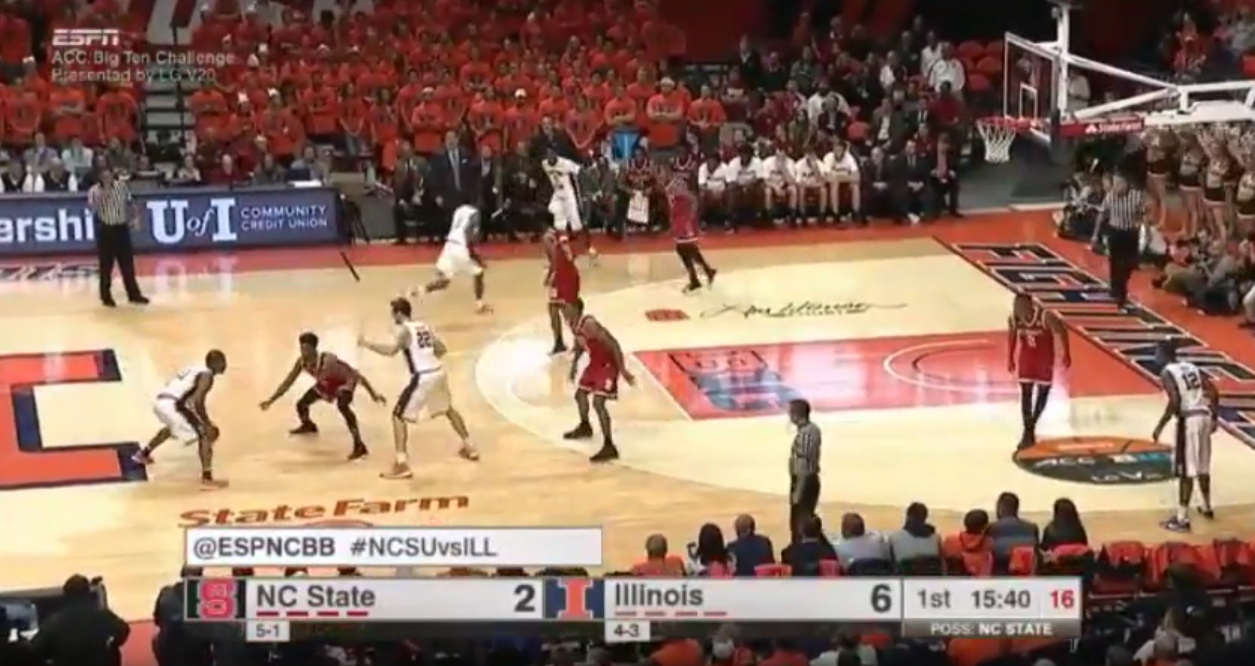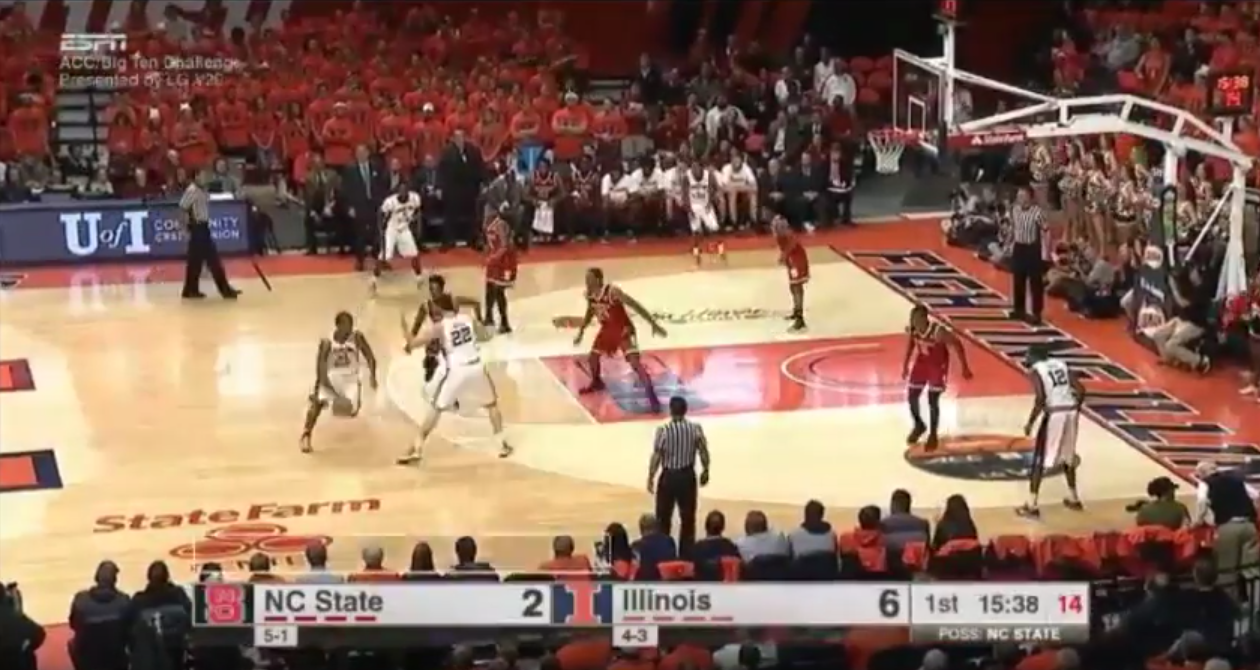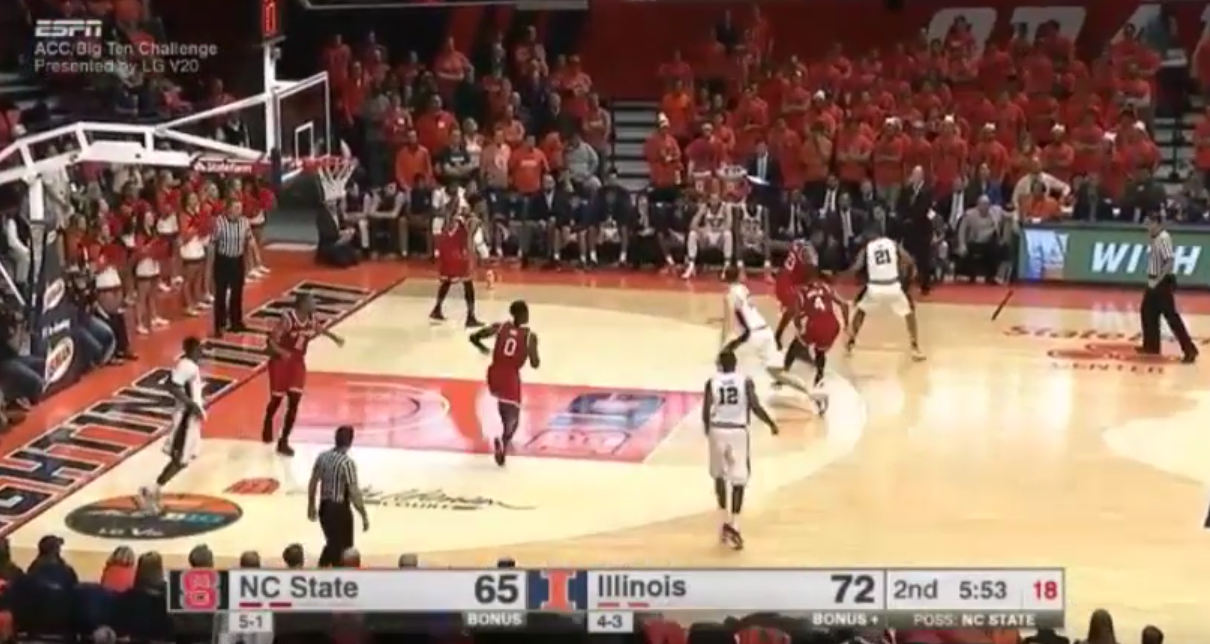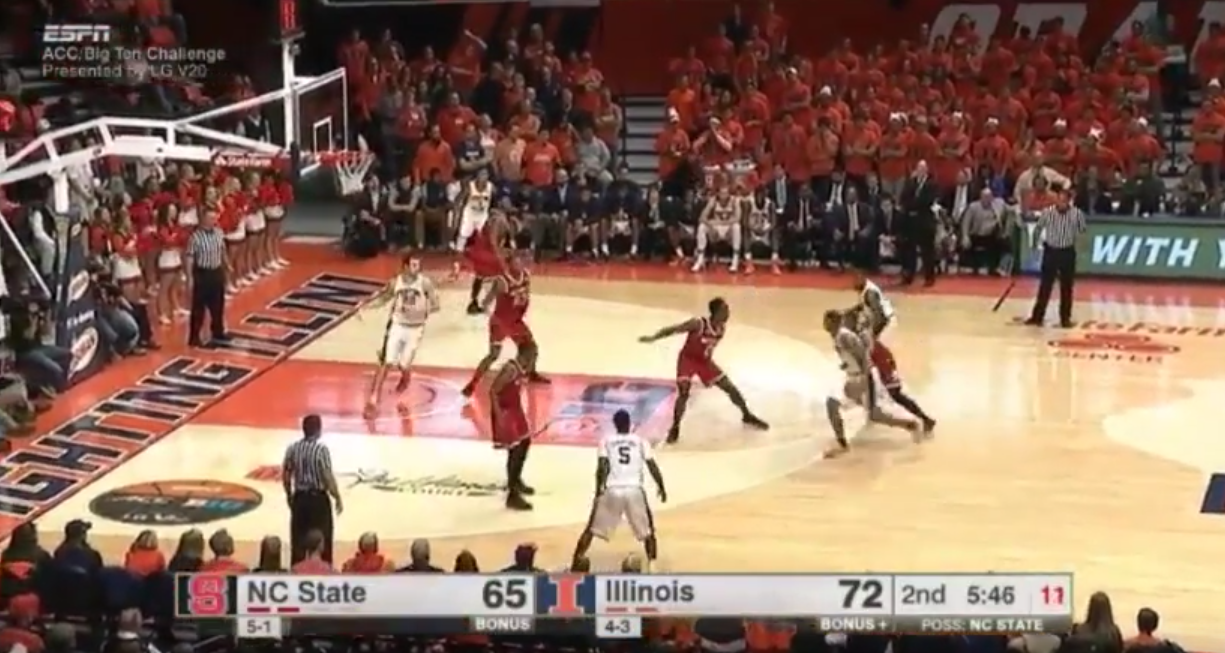This post is the third and final in a series breaking down the defensive deficiencies of State’s men’s basketball team. Check out parts one and two if you missed them.
Just as a quick note about Saturday night’s game before I get started. Coach Gottfried made the comment after the game that “we took a major step this week with our defense.” I will admit, I could only watch the first half of the game because of other commitments, and I understand we played a bunch of zone in the second half, so maybe there’s some cause for optimism. I’m skeptical though. Tennessee State is a very bad offensive team. They can’t shoot and they turn the ball over a ton. The one thing they do really well is offensive rebounding. Against us, they couldn’t shoot, they turned the ball over a bunch, and they killed us on the glass. Admittedly, this is better than the alternative, but I didn’t see any real reason to think that their poor offense was particularly caused by great defense. There were a lot of opportunities in the first half where they left points on the table not because we stopped them, but because they missed opportunities or had unforced errors. I also have doubts about our zone being effective against high level competition (since, you know, it never has been), particularly teams that can actually shoot. I hope I’m wrong and that this is a turning point, and again, maybe they were really good in the second half and I missed it, but I wasn’t all that impressed by our defense in the first half. The first 5 minutes or so were actually pretty brutal. Anyway, on to the real analysis.
Pick and Roll
Ah, the pick and roll (to be referred to as PnR from now on). The staple of most every offensive system. If you cannot defend the PnR, your team is in a world of trouble, because you’re going to see it over and over again. There are a couple problems I want to focus on with regards to our PnR struggles. The first problem is one of execution, the second is one of strategy.
So first of all, a problem of execution. We have trouble with allowing guards to go the wrong way and drive away from the help. What I mean by this is that when there is a PnR, the big man guarding the roll man, as well as the rest of the team, should be in position to help when the guard uses the screen. What that means is that if you are guarding the man with the ball, you want him to use the screen. Your team is set up to defend him if he uses the screen. If he goes away from the screen, he will likely have an open line to the rim. There is a defensive scheme based on denying the screen (called “icing” the screen), but we don’t play it (few college teams do), so we want to force opposing players to use the screen. We screw this up, both the on-ball man and the help-man, in a few different ways that you’ll see in the video below.
We’ve seen some of these plays before, but then we were focusing on the back-end help. Here we’re focusing on the point of attack. Now, I actually don’t think Illinois did a particularly good job of exploiting our PnR weaknesses, and you’ll note that we actually defend many of these plays successfully. That’s nice, I don’t care. This is about process, not results. So lets walk through them. The first play seems harmless enough, right? Here comes the first screen:
We’re way out behind the three point line, and Kapita is in perfect position to jump in front when Malcolm Hill drives around the screen. Instead, Henderson allows Hill to go left, away from the screen. He doesn’t get beaten, which is good. He slides his feet and doesn’t let Hill turn the corner. However, now Hill is going to turn back and use the rescreen. Now look at where we are:
Now the screen is a few steps closer to the basket, Henderson is a little out of position because he’s just switched directions, and Kapita isn’t in nearly as good position, since he slid over to stop Hill in case he beat Henderson. We were in very good position to defend the first screen, we’re not in good a position to defend this second screen. Henderson needs to play a little higher up, sit on Hill’s left side and make him use the screen. He also needs to not lunge towards the ball fake, if we’re being picky. You see a worse breakdown in this fashion in the last play. This, again, does not lead to points, but it’s not for lack of opportunity. Smith plays that one as if he’s trying to ice the pick, he jumps out and just lets the guard jet away from the screen and right past him. The Illinois guard gets into the teeth of the defense and makes a good pass, his teammate then screws up (helped by some good Markell Johnson defense). In the second play on the video, we also see some very good defense by Johnson to scramble and stay in front of his man. What we also see is that by going under the screen, Johnson gives his opponent an opportunity to reverse and go back to the other side of the court. The first screen is defended very well. When the second screen is used, though, Johnson goes under the screen. You are not supposed to do that in our system (as we’ll talk about in a second). Our standard scheme is that the big man shows, and the guard fights over top. When Johnson goes under, he and Kapita are occupying the same space, and that’s not particularly useful. If he goes over the screen, then he’s there preventing the opposing guard from turning back to the left side of the court. That’s a better outcome, you want to corral the ball-handler towards the sidelines when you can, it gives them less options. On the next three plays, you’ll see that Illinois really hurt us by flipping the screen on multiple occasions. I said some good things about Ted Kapita in my first post, and I’ll say some more later on here, but he gets burned really badly by this. In all 3 instances, Kapita ends up guarding the wrong side of the screen as the guard goes the other direction. On the third one they don’t even flip the screen, but it seems like Kapita is so mixed up at this point that he runs to the wrong side anyway. It’s pretty rough to watch, and it’s definitely something to keep an eye on as Kapita develops. Part of this may be due to a failure of the guard and big man to communicate, but as I can’t hear them, I can’t tell how much of the blame goes to that and how much is just Kapita’s poor positioning.
So those are errors of execution. Now, you certainly don’t like to see those, but with the exception of the Henderson play, these are all errors committed by freshmen, and that’s going to happen. It’s worth noting and watching to see if it’s a problem that keeps coming up, but I’m a little less worried about this than I am about our general PnR strategy.
So, there are a lot of ways to defend the PnR. Here’s a pretty good summary of the different approaches (the article is about NBA teams, but it’s basically the same for college teams). What we have typically done is what I might describe as a soft show. The big man typically isn’t as deep as shown in the “zone up” example (sometimes when it’s Anya he’s about that deep), but we’re also not showing aggressively. Usually the big man sits about a step or two behind the man setting the screen, and kind of slides along until the guard can recover. You can see what I mean in the video:
This is a very passive way to defend the PnR. There’s no pressure put on the ball-handler, and you don’t really do anything to restrict his movement or passing lanes. So, why is this a problem? First, you’re allowing the offense to dictate exactly what they want to do, you’re not forcing them any particular way. Second, even though it seems like keeping the big man further back would make it easier for him to show and recover, that’s often not the case. Because you’re not stopping the ball or offering any resistance, the guard can keep dribbling and the big man defender has to follow until his teammate can recover. Once that guard turns the corner he can string that big man along, and then there’s quite a large distance to cover to get back to your man. You can see that in the first play, and then particularly in the fourth play. Third, you’re wasting opportunities to pressure the offense and potentially create turnovers. Look at the third clip in the video. If Henderson steps up and defends at the screen instead of 2 steps back, you completely snuff out that play. They handed us an opportunity to trap a guard on the sideline, and we didn’t take it. Lastly, you give up open passing lanes. When you give no resistance and let the guard turn the corner, you open up every passing option to him. I included the play at the end from a game vs. Virginia a couple years ago because it’s a pass we’ve seen hundreds of times over the last few years of NC State basketball. I’ve seen that roll and pocket pass burn us so many times. Because the big man is playing so far back and you allow the guard to turn the corner and get vision, there’s nothing to stop that. A jumper is the best case scenario, because often that play ends with a big man barreling down the lane for a dunk.
Lets contrast this with what Ted Kapita does on a few plays in this game:
Now that’s how you show on a screen. Note how much closer to the screen he’s meeting the offensive player. He doesn’t leave room for them to turn the corner and get a head of steam. He isn’t leaving the ocean of space there for that pocket pass. When the offensive player comes off that screen, he is immediately met with a big man in front and his defender is chasing right behind him. At this point he can keep dribbling, but he’s forced to go out towards the sideline, not downhill towards the basket. That means he’s not a threat to score, his vision of the floor is restricted, and his passing angles are worse. Often, it just forces the guard to pick up the ball. Now, in this first play you see one screen successfully defended, then you see Malcolm Hill split the screen and get a layup. I’m actually pretty okay with that. Kapita was a hair late getting to his spot, but Hill is a really good player who made a good move, that happens. If I’m going to get beat, I want it to be because I forced the other team to make tough plays, not because I fed them a constant stream of easy options. Here’s a perfect example of the difference between the two approaches. On this play, Kapita is going to defend the first screen and Abu the second. Note the difference:
Kapita meets the ball-handler right at the three point line and turns him towards the sideline. His back is to the middle of the floor, so he has limited sight lines. In fact, the pass he ends up making is a blind pass. If Dorn on the backside reads the play faster, that’s a steal and 2 going the other way.
Abu, on the other hand, hangs back a couple steps and meets the ball handler at the free throw line. Hill has turned the corner, he’s headed towards the basket, and he’s dragging Abu away from his man.
That’s the difference. I know which one I prefer.
Now, obviously there is going to be some variation in your PnR coverages based on personnel, but our base approach is this soft show, and I think it’s a terrible idea. My preferred method of PnR defense at the college level is hedging with an occasional trap, but I’d settle for anything more aggressive and proactive than what we’re doing now. I’ll maybe give you that Anya needs to hang back more (but I don’t really even believe that), but there’s no reason Abu can’t do what Kapita is doing in those plays. When you sit back like that, you are asking your opponent to pick you apart, and good opponents will happily oblige.
Wrapping Up
I’ve been pretty rough on some folks in these posts. Abu, in particular, has not come out looking good. I want to be clear, I don’t hold that against him. By all accounts I’ve seen, he’s a good kid who works really hard. He came to State as basically a super-athletic lump of clay that needed to be molded into a basketball player. For all his offensive growth, he has not been molded into a defensive player. While players have to take responsibility for their individual mistakes, ultimately the blame for systematic defensive failures falls on the coaching staff. I also want to be clear that I have nothing against Mark Gottfried. Gottfried has some real strengths as a coach, and the program now is in better shape than it was when he came in. At the same time, it is immensely frustrating watching the same defensive struggles year after year. Look, he might have a different defensive philosophy than me, and that’s fine. There are lots of great coaches who coach vastly different approaches to defense. That’s fine…if it works. At some point, though, you have to look at the numbers, have a come to Jesus moment, and say “this isn’t working.” I genuinely hope that things turn around, that this team starts to build a culture that prioritizes defense. I hope these mistakes are fixed. I hope I never have to make a post like this again. Unfortunately though, the evidence of the last few years seems to indicate that the coaching staff doesn’t really seem to consider this a serious problem. I think I’ve shown that it is. If nothing changes, that has to fall on the head coach. I’ve enjoyed the Sweet Sixteen runs and good recruiting classes, but NC State is not going to get to where it wants to be if it’s never better than the 70th best defense in the nation. Something has to change.







You must be logged in to post a comment.